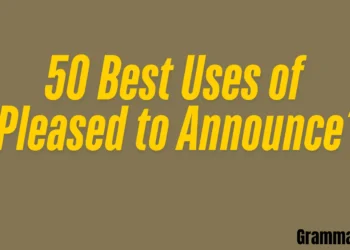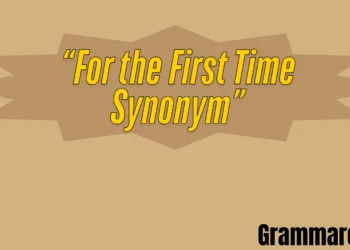The language A popular verbal transition, “By the way,” is sometimes questioned in corporate situations. Its tone and effect vary according to context, audience, and delivery, even if it can sound laid-back and amiable. Knowing when and how to utilize it will enable one to preserve politeness while still keeping talks natural.
Some people wonder if official emails or meetings might come off as too informal or dismissive. Used properly, though, it may gently present other ideas without interrupting the flow. Its sense, tone, ideal application contexts, and situations when it should be avoided are all discussed in this piece.
Is It Professional/Polite to Say “By the Way”?
Although By the Way is often used in everyday chats, its suitability in professional contexts depends on tone and situation. In communications with coworkers or team meetings, it can sound natural and welcoming. More elegant choices like additionally fit better, though, in official reports or client correspondence. The secret is to align the colloquial nature of the word with your audience’s expectations.
What Does “By the Way” Mean?
In discussion, this oft-used transitional phrase sets an afterthought or minor topic. It translates as along the way, implying a little deviation from the main subject. One instance: The project is on track. Have you seen the most recent research, by the way? It lets thoughts be connected easily without harsh subject changes.
When to Use “By the Way”
Suitable for short emails, friendly reminders, or casual workplace conversations, this phrase helps to maintain a comfortable level of communication. It is effective when the extra point is relevant but not essential. But stay clear of using it for important notices or sensitive material requiring a more direct introductory approach.
What Tone Does “By the Way” Carry?
Usually suggesting that the extra point is minor or incidental, the expression usually has a casual, colloquial tone. Although it can make requests seem less taxing—By the way, could you check this?—overuse can indicate disorder. It runs the risk of seeming too casual or unprepared in formal situations.
When to Avoid Using “By the Way”?
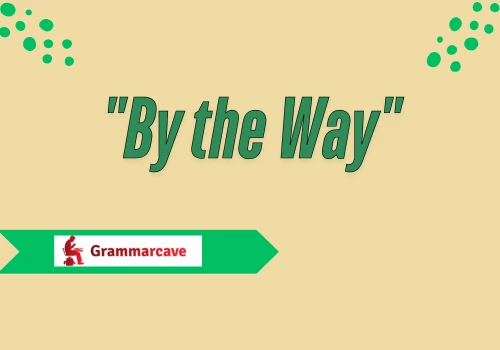
Avoid this phrase in official documents, formal proposals, or when talking to bosses in very traditional work environments. Additionally, it is best avoided when introducing sensitive topics or critical updates that need a more intentional approach. Prefer instead for more straightforward transitions like It’s important to note that… or Another consideration is and Also check The Complete Guide to Correct Spelling and Usage Messege Vs Message on this Blog.
1. Just so you know
Meaning: Giving clarifying or useful information
Definition: An introduction to a piece of information or update the listener might find beneficial
Explanation: Frequently used to casually alert someone of something they may not be aware of.
Example: “Just so you know, the meeting has been moved to 3 p.m.”
Best use: relaxed reminders, casual work discussions, friendly updates
Worst use: Legal papers and formal communications are the worst use.
Tone: Casual, enlightening, informal.
2. Oh, and…
Meaning: Adding an extra idea
Definition: A casual comment used to add something to an earlier declaration
Explanation: Commonly used in chat to remember or include one further point
Example: “Oh, and don’t forget to bring your charger!”
Best use: Casual writing, text messages, daily speech
Worst use: Business emails, professional conferences
Tone: Conversational, relaxed, warm
3. Speaking of which
Meaning: Connect one related subject.
Definition: A term that moves toward a topic related to the one just spoken of.
Explanation: Supports the flow of the discussion while slightly altering the course
Example: “I saw Sarah yesterday. Speaking of which, have you answered to her email?”
Best use: smooth subject transitions in light or casual business conversations
Worst use: rigorous legal debates or academic writing
Tone: smooth, casual, natural
4. That reminds me
Meaning: Inspired by a fresh, connected idea.
Definition: A method of presenting an idea inspired by ongoing dialogue
Explanation: Often employed when something said recalls anything else
Example: “We were discussing your automobile; that brings to mind your brakes require repair.”
Best usage: friend chats, brainstorming sessions
Worst use: Formal reports, strict presentations
Tone: contemplative, impulsive, informal
5. Before I forget
Meaning: Share something crucial before it fades from your memory
Definition: Used to provide a reminder or detail definition proactively:
Explanation: It is common in conversations to remember anything significant while it’s called back
Example: Your appointment is at 11 a.m. tomorrow before I forget.
Best Use: Friendly reminders, meetings, and planning sessions are ideal uses.
Worst use: Legal arguments or highly formal speeches
Tone: Practical, rapid, casual
6. On another note
Meaning: Moving to another subject
Definition: A soft approach to leave the present topic
Explanation: Employed to swing without sounding sudden
Example: “The event was successful. On another note, did you see the new budget update?”
Best uses: conversations, friendly meetings, mild topic changes
Worst use: abrupt or unrelated email signoffs
Tone: Smooth, balanced, semiformal
7. I almost forgot
Meaning: Recollection of anything just in time
Definition: A saying that comes before an afterthought or forgotten fact
Explanation: Often matched with a short break or moment of understanding
Example: “I nearly forgot — your delivery arrived this morning.”
Best Use: personal contacts, casual updates.
Worst Use: formal reports or documents
Tone: Open, modest, casual
8. While we’re talking
Meaning: Use the present discussion to raise a different angle.
Definition: Used to include pertinent information while a topic is still ongoing
Explanation: Aids in the grouping of related concepts
Example: “Should we reserve the hotel while we are discussing the travel?”
Best Use: Team conversations and planning meetings are best used.
Worst Use: scholarly writing or legal negotiations
Tone: casual, cooperative, practical
9. By the by
Meaning: Said differently as “by the way.”
Definition: A classic or fanciful rendition of adding further information
Explanation: Somewhat mischievous; functions in light conversation or storytelling
Example: “By the bye, your cat video went viral!”
Best Use: Top uses include humorous writing, narrative, and casual conversations.
Worst Use: Modern professional use and corporate papers are the worst uses.
Tone: Nostalgic, playful, odd
10. In case you didn’t know
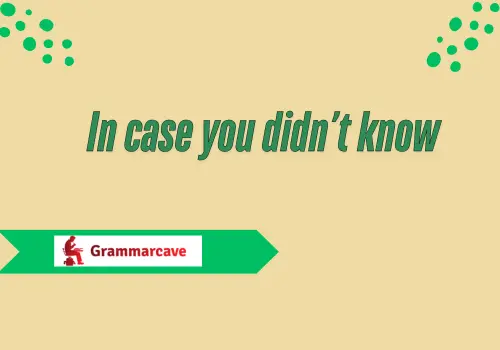
Meaning: Presenting possibly unfamiliar information
Definition: A mild or sarcastic opening to convey a reality
Explanation: Based on tone, it can either be beneficial or mocking.
Example: For one thing, the deadline is today, in case you didn’t know.
Best use: reminders, social media, kind clarifications.
Worst use: Passive/aggressive office emails
Tone: Sarcastic or informative, depending on tone.
11. You know what?
Meaning: Establishing a revelation or modification
Definition: A rhetorical tool indicating an abrupt idea or change
Explanation: Often produces anticipation or emotion
Example: “You know what? Let’s go the scenic path.”
Best uses: narrative, personal counsel, theatrical panache
Worst use: Corporate reports, technical papers
Tone: spirited, informal, impulsive
12. And hey…
Meaning: Adding another point softly
Definition: A friendly approach to adding a thought or suggestion is
Explanation: Frequently lowers the intensity of a request or comment.
Example: “Hey, thanks once more for volunteering.”
Best use: friendly emails, casual talks
Worst use: Professional or critical comment
Tone: friendly, warm, laid-back
13. Not to change the subject, but…
Meaning: Introduction to a subject change
Definition: A polite gesture before moving the conversation
Explanation: Helps to regulate multitopic discussion flow.
Example: “Not to change the subject, did you phone your mother?”
Best use: Group talks, personal conversations
Worst use: Very structured formal meetings
Tone: relaxed, informal, kind
14. As an aside
Meaning: introducing a second idea
Definition: A comment not pertinent to the primary topic
Explanation: Suitable for parenthetical or background information
Example: “The venue might be under repair as an aside.”
Best Use: essays, lectures, side notes
Worst use: Oneonone sensitive chats
Tone: intellectual, kind, understated
15. Also…
Meaning: Include additional data.
Definition: a fundamental link for more ideas
Explanation: neutral and extremely flexible
Example: “Also, lock the doors.”
Best usage: task additions, lists, emails
Worst Use: In official papers, filler or overused content
Tone: neutral, flexible, simple
16. P.S.
Meaning: In writing postscript
Definition: an added note following the main message concludes
Explanation: Often found in letters and emails for final thoughts
Example: “P.S. Leave your coffee in the refrigerator.”
Best use: Emails, letters, messages
Worst use: linguistic dialogues; technical papers
Tone: Casual, personal, light
17. Not that it matters, but…
Meaning: Providing a maybe irrelevant point
Definition: Proposing knowledge possibly rejected
Explanation: Depends on tone; may be passive-aggressive or modest.
Example: “Not that it matters, but I did advise this last week.”
Best Uses: Informal dialogues, friendly conversations
The worst uses are official meetings and corporate disputes.
Tone: understated, sardonic, or passive, depending on the application
18. Not sure if I told you…
Meaning: Verify whether or not you have shared information already.
Definition: Intro to a probable repeating of knowledge
Explanation: Applied when there is doubt about earlier communication
Example: “Not sure if I told you, but I got the job!”
Best use: Friendly updates, catching up
Worst use: Contractual papers or official documents
Tone: Gentle, conversational, warm
19. Come to think of it
Meaning: Awakening or recall
Definition: A recall phrase used to retrieve fresh knowledge
Explanation: Signals a thought caused during dialogue
Example: Come to think of it, we never completed that report.
Best use: brain dumps, storytelling
Worst use: Technical meetings or high-level memos
Tone: contemplative, natural, reflexive
20. As it happens
Meaning: Either co-incidentally or unplanned
Definition: Used when something happens or aligns precisely in time
Explanation: Introduces ironism, chance, or surprise
Example: “I was just heading your way as it happened.”
Ideal Use: Literary writing, casual stories
Worst case: precise reporting or scientific papers
Tone: humorous, narrative, somewhat sarcastic
21. On a different note
Meaning: changing to a different subject
Definition: A transitional statement to shift the topic without abruptness
Explanation: Used to guide the chat toward anything else gently
Example: “That project went well. On a different note, did you see the new intern?”
Best use: Meetings, email updates, and expert conversations are the best use.
Worst use: Highly structured legal or scientific writing
Tone: Neutral, smooth, professional tone
22. Just putting it out there
Meaning: Proposing an idea without coercion
Definition: A gentle manner of sharing an idea or view
Explanation: It lets the speaker express an idea while reducing conflict.
Example: “Just putting it out there — we could skip the meeting and send an update instead.”
Best Use: Brainstorming, group talks, concept pitching
Worst application: formal policy suggestions, courtrooms
Tone: Open, casual, tentative
23. Something else…
Meaning: More data for distribution
Definition: An incomplete phrase implies another point is nearing.
Explanation: Used to transition into a different or auxiliary idea.
Example: Something else; the printer has been acting up again.
Best Use: Team meetings, informal conversations
Worst Use: academic papers or final reports
Tone: light, informal, incomplete
24. While I’m at it
Meaning: Doing or saying extra when already involved
Definition: A segue phrase for ease or simplicity
Description: Introduces related ideas or tasks in the same setting.
Example: “I will also clean the whiteboard while I am at it.”
Best Use: Casual Updates, situations involving multitasking
Worst uses: Formal introductions or statements
Tone: casual, efficient, pragmatic
25. Oh yeah…
Meaning: either adding or remembering something
Definition: A spontaneous phrase used when recalling a thought defines it.
Explanation: This often indicates that the speaker is returning to something they overlooked.
Example: “Oh yeah, your book came in the mail.”
Best use: Informal reminders, casual conversation
Worst Use: Serious contexts or professional environments
Tone: Friendly, lazy, impulsive
26. Just throwing this out there
Meaning: Making a casual proposal
Definition: Rather like “just putting it out there,” but with just a bit more guts.
Explanation: Explains how the speaker is presenting an idea or thought for evaluation.
Example: “Just throwing this out there—what if we cancel Friday’s meeting?”
Best Use: Brainstorming, informal group discussion
Worst Use: Legal records, corporate boardrooms: worst usage
Tone: Bold, casual, open, light
27. And another thing
Meaning: Including a followup or further idea
Definition: A laid-back shift to bring up yet another point.
Explanation: Usually follows a list or sequence of ideas.
Example: “And still another thing — the software is still in need of an update.”
Best Use: Most effectively used argument and spirited dialogue.
Worst Use: Formal environments or organized speeches are the worst applications.
Tone: assertive, casual, sometimes combative.
28. Let me add
Meaning: Giving more information
Definition: A gentle sentence that builds on a prior idea.
Explanation: Applied in deliberate or intellectual dialogues
Example: “Let me remark that we also lowered response time.”
Best Use: Debates, professional emails, presentations
Worst Use: Casual speech overuse
Tone: formal/informal blend; informative; respectful
29. Guess what?
Meaning: Creating suspense or shock
Definition: A rhetorical lead to present intriguing or unexpected data
Explanation: Adds a sense of expectation to the discourse.
Example: “Guess what? We won the contract!”
Excellent use: friendly chats, congratulatory messages
Worst case: Formal business or major news
Tone: Vibrant, playful, eye-catching
30. While I remember
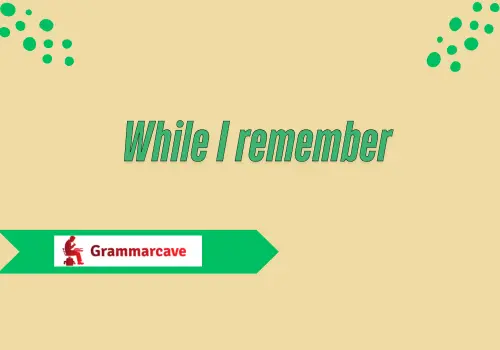
Meaning: Telling something before losing memory
Definition: An exclamation uttered when a thought is still fresh.
Explanation: It helps avoid memory lapses during conversations.
Example: Though I remember, I need that report by midday.
Ideal use: informal work chats, daily planning
Worst Use: formal writing; legal debate
Tone: Casual, natural, pragmatic
31. I should mention
Meaning: Emphasizing something may be significant
Definition: A little phrase to call attention to a point
Explanation: Signals the information may be relevant or useful
Example: “Next month we should bring up our platform switch.”
Ideal use: talks, email notes, updates
Worst Use: redundant in very complex situations
Tone: Respectful, gentle, thoughtful
32. Can I say…
Meaning: Beginning a personal opinion
Definition: Employed to ease the introduction of a remark or emotion
Explanation: It could act as a courteous interjection.
Example: “Can I just say… you did an excellent job!”
Best use: Best uses are compliments and opinions in chats.
Worst Use: Objective technical writing is the worst use:
Tone: Expressive, warm, personal
33. In case it wasn’t clear
Meaning: Stressing a point once again
Definition: A means of clarifying or repeating something
Explanation: Used when you feel a point might’ve been missed
Example: “In case it wasn’t clear — this deadline is nonnegotiable.”
Ideal Application: Team communications or meeting reinforcement
Worst use: feels condescending if overused
Tone: Straight, strict, maybe corrective.
34. For the record
Meaning: Stating something formally or firmly
Definition: Used to clarify your position or make sure something is noted
Explanation: It may underscore or record an idea.
Example: “For the record, I told them to wait.”
Best use: formal disputes, clarifications, debates
Worst use: Offtopic, unrelated talks.
Tone: Assertive, official, often protective
35. You might be interested to know
Meaning: giving listener-relevant information
Definition: Offering interesting or beneficial data
Description: Often used to draw someone’s attention with context
Example: “You could be curious to learn that the event is completely packed.”
Best use: Educational chats, customer service, emails
Worst case: Jargon-heavy or passionless updates
Tone: polite, informative, fascinating
36. It just occurred to me
Meaning: Suddenly understanding something
Definition: An unplanned expression of a fresh idea.
Description: Usually points to a practical or surprising idea
Example: “It just struck me — we missed to reserve a round trip ticket!”
Best use: brainstorming, informal chat
Worst use: Academic research or organized writing
Tone: Reflective, impromptu, natural
37. Just adding…
Meaning: Additional input
Definition: A short approach of more details without overwriting
Description: Functions in email or chats continue like in this case.
Example: “Just adding that he is also the lead designer of the project.”
Best Use: Quick Upgrades, Followup Emails
Worst Use: extensive formal papers
Tone: light, neutral, complementary.
38. Oh, just remembered
Meaning: A remembering of a recent thought
Definition: An instinctive phrase to introduce something forgotten
Explanation: Often adds urgency or helpful detail
Example: “Oh, just remembered: there’s no wifi at the event.”
Best uses: Team communications, personal reminders
Worst Use: formal briefings or presentations
Tone: Casual, friendly, fast
39. A random thought
Meaning: An off-topic thought or observation
Definition: Beginning for an unrelated or humorous comment
Explanation: Used to add personal or light commentary.
Example: “A random thought—why aren’t keyboards pastel-colored?”
Best use: Creative spaces, social media, casual conversations
Worst Use: concentrated, serious discussions.
Tone: light, casual, offbeat
40. Just FYI
Meaning: For your information.
Definition: A fast and casual means to provide a helpful detail.
Explanation: Used when the speaker believes the listener might profit from the material
Example: “Just FYI, the lunch spot closes early on Fridays.”
Best use: Ideal applications include friendly reminders and notes sent through email.
Worst Use: Overused in formal tone or passive/aggressive use.
Tone: Neutral, practical, depending on the tone employed.
41. Incidentally
Meaning: Coincidental or furthermore
Definition: Introduces something related but not central to the main issue.
Explanation: Sometimes employed to give background information or context.
Example: “The vendor also works with our rivals, by the way.”
Best use: Formal writing, emails, and briefings are best used.
Worst use: intimate or emotional communication
Tone: Formal, polished, neutral.
42. Moreover
Meaning: Apart from what was already written
Definition: A formal link meant to expand or support an argument
Description: Gives importance or presents encouraging details.
Example: “This approach also lowers expenses considerably.”
Ideal use: Academic writing, corporate reports, persuasive papers
Worst use: Informal chats or casual messaging
Tone: Formal, assertive, logical.
43. Additionally
Meaning: As something more or extra
Definition: A term starting a second or more point
Description: Common in formal or organized papers to enumerate ideas.
Example: Furthermore, our client base has increased by 20 percent.”
Best usage: Professional emails, presentations, reports
Worst use: intimate talks or emotional writing
Tone: Official, educational, straight.
44. As an additional note
Meaning: including one further detail or point
Definition: a gentle switch providing additional information
Description: Help maintain a respectful tone while including essential context.
Example: “Please CC the legal team in future updates; as an added remark.”
Best Uses: Emails, presentations, papers
Worst use: casual language or unofficial texts
Tone: Formal, polite, illustrative
45. On a related note
Meaning: Presenting a subject related to the last one
Definition: A transitional word used to move to something pertinent
Explanation: Without sounding abrupt, smooth transitions.
Example: For instance, “On a related note, the client is asking for corrected designs.”
Best Uses: review projects, team meetings, updates.
Worst use: stern legal or scientific discussion
Tone: deliberative, semiformal, consistent
46. In addition
Meaning: Further or extra information
Definition: Used to link or develop concepts
Explanation: Common words in organized communication include:
Example: “Besides the renovations, we tightened security measures.”
Best Uses: Academic writing, project reports, formal debates best use:
Worst use: colloquial or slang-based dialogues
Tone: Formal, ordered, thorough Tone
47. It’s worth noting
Meaning: Spotlighting a main idea
Definition: A polite suggestion to emphasize anything significant is defined as:
Explanation: Often used to point the reader toward significance
Example: “It is worth mentioning that delays are forecast because of weather circumstances.”
Best use: professional emails, reports, presentations
Worst use: casual chats
Tone: Diplomatic, neutral, informational
48. It is pertinent to mention
Meaning: Important detail next
Definition: Shows that the contextually suitable information is below.
Explanation: Support of clarity or validation of judgments
Example: “It is relevant to note that this policy change corresponds with compliance.”
Best use: Legal writing, policy briefs, official memoranda
Worst use: casual group chats or daily speech
Tone: Formal, exact, official tone.
49. As a side note
Meaning: An extra fact or observation
Definition: Emphasizes a pertinent but minor idea.
Explanation: Often used in talks or presentations to moderate tone
Example: “The parking lot will be under maintenance as a side note.”
Best Uses: meetings, webinars, newsletters
Worst use: Contracts or legal papers
Tone: Relatively formal, instructive
50. As previously mentioned
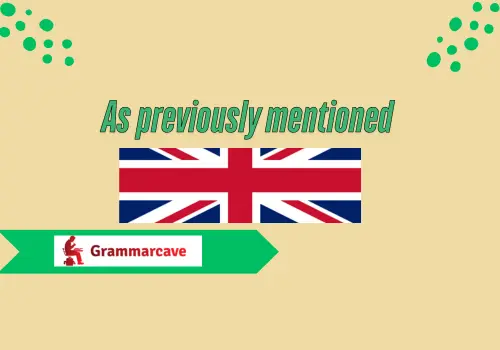
Meaning: Relates to prior material.
Definition: Information already discussed is recalled or summarized.
Description: Reinforces remembering or continuity
Example: “As previously mentioned, the deadlines are nonnegotiable.”
Best use: Reports, policy conversations, follow-up emails.
Worst usage: informal storytelling or chats
Tone: stiff, formal, referential
51. For your information
Meaning: Distributing anything that could be beneficial
Definition: An unbiased statement presenting relevant but nonurgent information
Description: Usually included in emails or updates as a courtesy
Example: “The report was completed yesterday for your knowledge.”
Best Uses: Internal Updates, Informational Emails
Worst use: The worst application is if used sarcastically or passively aggressively.
Tone: Neutral, kind, instructive tone
52. For your awareness
Meaning: Give something the recipient ought to be aware of.
Definition: Used to let someone know of pertinent context
Description: Commonly employed in structured communications, somewhat more formal than “FYI.”
Example: “For your information, these adjustments influence Q4 planning.”
Best Use: policy sharing, HR upgrades, corporate communication
Worst use: text or casual chats
Tone: formal, precise, professional
53. Worth mentioning
Meaning: points to something remarkable or significant.
Definition: A statement to emphasize significance without hyperfocus.
Explanation: Helps to guarantee little points are not ignored
Example: “It should be noted that we reduced 15% by changing suppliers.”
Best uses: performance evaluations, business meetings
Worst use: Overuse can make it lose its effect
Tone: informative, cautious, medium
54. Let me add that…
Meaning: Adding a new or backup point
Definition: A light saying to provide another fact.
Explanation: Typically used in explanatory or persuasive situations
Example: “Let me add that our market share also grew in Q1.”
Best Uses: Lectures, strategic emails, conversations
Worst Use is extensively used in everyday talks.
Tone: Kindly, careful, encouraging
55. On that point
Meaning: Continuing with a linked topic
Definition: a link that supports or develops a debate
Explanation: Helpful in organized arguments or debates
Example: “We should also take audience demographics into account.”
Ideal uses include formal meetings, team discussions, and academic writing.
Worst usage: Unofficial storytelling
Tone: Logical, organized, analytical
56. About
Meaning: Relating to a specific topic; significance.
Definition: Introduces or elucidates the subject of conversation
Explanation: Frequently seen in formal or legal documents.
Example: Regarding your request, the file has been shared.
Ideal uses: Formal letters, contracts, emails
Worst case: Casual messages and relaxed conversations
Tone: Formal, systematic, professional
57. Per our earlier conversation
Meaning: Referring to an earlier conversation
Definition: Something already discussed is politely reminded.
Explanation: Useful in verifying prior agreements or followup.
Example: “Per our earlier discussion, Friday is the deadline for the revised draft.”
Best uses: followups, negotiations, professional emails.
Worst use: day today language
Tone: Friendly, professional, relatively assertive
58. Supplementary to that
Meaning: Giving supplementary related information
Definition: Gives the prior point supporting or supplementary information.
Explanation: Frequently employed in documents or organized writing
Example: “Additional to that, we’ve included a user feedback report.”
Best Uses: business papers, academic writing
Worst usage: casual meetings or verbal interactions
Tone: Supporting, academic, formal
59. For clarity
Meaning: helping in better comprehension
Definition: Employed when further explaining or simplifying a complex argument
Explanation: Clarifies ambiguity or defines technical jargon:
Example: For clarity, the dashboard updates every 6 hours.
Best application: training, documentation, technical writing
Worst usage: Overused in already plain contexts.
Tone: Frank, beneficial, descriptive
60. Furthermore
Meaning: Enhances an argument’s strength or details.
Definition: A formal connector comparable to furthermore
Explanation: Used in persuasive writing to keep making an argument.
Example: “Moreover, the findings support our starting points.”
Best uses: academic journals, convincing writing, reports
Worst use: Daily chat or emails
Tone: Formal, persuasive, organized
61. If I may add
Meaning: Offering politely more input
Definition: A courteous way to introduce another idea
Explanation: Used in debates or arguments to provide insight without interference, it
Example: “If I may add, our direction is supported by the market analysis.”
Best uses: Respectful debate, formal meetings, team talks
Worst use: TOO informal chats
Tone: respectful, formal, cooperative
62. In this context
Significance: within the present context or framework
Definition: A statement linking facts directly to the subject at hand
It helps to clarify how a point relates to a specific context.
“In this environment, the choice makes perfect sense.”
Best uses: academic writing, thorough reports, policy statements
Worst use: unrelated or broad conversations
Tone: Analytical, exact, official
63. Relatedly
Meaning: Associated with the present theme
Definition: A formal transitional term linking a different yet related concept
Explanation: Changes from one topic to a relevant one with ease.
Example: “Relatedly, user retention has also increased.”
Best use: analytical writing, essays, reports
Worst application: casual chat
Tone: Sophisticated, coherent, formal
64. One more thing to note
Meaning: Including a last or additional point
Definition: Signals an additional idea that might be significant.
Explanation: Improves contact with a detail still not covered.
Example: One other item to remember: the deadline is strict.
Best application: Emails, conversations, presentations
Worst use: Overused or repetitive in brief communications
Tone: Informative, organized, somewhat official
65. Adding to this
Meaning: Using a previous idea
Definition: a continuation phrase to spread knowledge
Explanation: Often used in organized communication to improve coherence.
Example: “Adding to this, the results have surpassed our expectations.”
Best application: reports, analysis, ideas
Worst use: Overutilized in common writing
Tone: Formal, logical, supportive
66. It’s also relevant to say
Meaning: Providing relevant material
Definition: Indicates how the topic is tied directly.
Explanation: Frames new material in a contextually significant light.
Example: “It is also pertinent to note that we were first to market.”
Best use: presentations, debates, records
Worst use: Conversational chats
Tone: Wise, formal, composed
67. As part of that
Meaning: An element of a larger concept
Definition: Designates a particular within a broader concept
Explanation: Used to show that a point forms part of something bigger
Example: “As part of that effort, we started weekly reviews.”
Best use: Ideal application is in strategic updates and organized writing.
Worst use: Worst usage is when one moves to an unrelated concept.
Tone: understandable, organized, logical
68. Regarding that
Meaning: Referring to the prior topic
Definition: Relates to and develops on a point recently raised.
Explanation: Helps to maintain a clear and focused conversation.
Example: “Concerning that worry—we scheduled another test.”
Best use: written answers, responses, clarifications
Worst uses: beginning unrelated topics
Tone: Direct, orderly, semiformal
69. Notably
Meaning: Entitled to particular notice
Definition: Emphasis on significance or relevance defines it.
Explanation: Emphasizes a notable point or distinction.
Example: “Remarkably, customer satisfaction soared 40% this quarter.”
Best use: executive summaries, reporting highlights
Worst application: emotional or casual conversation
Tone: authoritative, formal, emphatic
70. A quick note
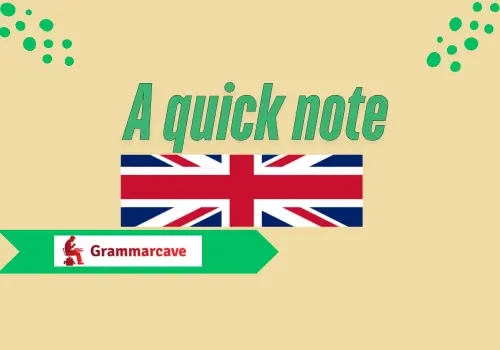
Meaning: A little bit of practical information
Definition: Lightly brings up a minor issue.
Explanation: Used to inject something quickly into conversation or writing.
Example: “A short message: The elevator is being serviced today.”
Best use: emails, memos, team communications
Worst application: Legal writing or technical papers
Tone: Concise, laid-formal, effective
71. Allow me to add
Meaning: Kindly provide more clarity
Definition: One courteous manner to present another comment
Explanation: Suggest a polite contribution to the current conversation.
Example: Let me say that this accords with our ideals.
Best use: Business emails, formal gatherings
Worst application: Much too formal for casual talks
Tone: Formal, respectful, composed
72. Just a brief note
Meaning: A little and fast bit of information.
Definition: Introduces a concise, unobtrusive remark
Explanation: Used when the speaker wants to interrupt lightly
Example: “Just a quick message—the timeline may change somewhat.”
Best use: emails, memoranda, revisions
Worst application: where thorough debate is required.
Tone: Polite, light, semiformal
73. Complementarily
Meaning: Adding something that helps or improves
Definition: A formal means of support conveyed via further information
Explanation: Often used to denote ideas or points that support each other.
Example: “Complementarily, we’re also modifying the training procedures.”
Best use: Research, thesis papers, high-level proposals
Worst application: Casual or quick talk
Tone: Formal, analytical, advanced
74. A minor detail
Meaning: a little but significant piece of information
Definition: Though the point might not be central, signals still count.
Explanation: Used to recognize modest but genuine additions
Example: “A little detail — the login page has a fresh design.”
Best uses: verbal presentations, summaries, reviews
Worst use: when the detail is essential
Tone: low, observant, soft
75. To Point Out
Meaning: stressing a specific
Definition: A phrase meant to emphasize a particular quality
Explanation: Used for emphasis or clarification:
Example: “Just to point out, these results reflect only Q1 numbers.”
Best use: Suggestions, revisions, clarification
Worst use: Sarcastically or too often
Tone: straightforward, concise, informal, neutral
76. One additional detail
Meaning: Adding a last, extra piece of knowledge
Definition: Signals more information that hasn’t been covered yet
Explanation: Keeps communication complete without sounding overly formal.
Example: “One more fact: the final invoice shows all the discounts.”
Best uses: business emails, project updates
The worst use is storytelling or informal texts.
Tone: Expert, clear, impartial
77. This also applies to…
Meaning: Elsewhere, the same rule or data is good.
Definition: A phrase used to apply a principle or detail to other situations
Explanation: Guarantees the audience sees greater relevance.
Example: This also applies to international accounts.
Best Applications: instructions, procedures, training
Worst use: Poetic or narrative writing is the worst usage.
Tone: Reasonable, explanatory, educational.
78. Touching on another point
Meaning: adding another point of view or side
Definition: A mild approach to changing direction within a pertinent conversation
Explanation: Maintain thematic flow without sounding harsh.
Example: “Touching on another point—let’s discuss scalability.”
Best use: organized debates, presentations
Worst use: quick or slang-heavy conversations
Tone: Formal, coherent, considered
79. Not to be overlooked
Meaning: Making clear something shouldn’t be overlooked
Definition: Notification of the great significance of the material to follow.
Explanation: Emphasizes the importance of a perhaps undervalued argument.
Example: Not to be forgotten—our customer base grew in two years.
Best use: summaries, analyses, impact reports
Worst use: frequent talks or sarcastic tones
Tone: Formal, strategic, emphatic.
80. Just a clarification
Meaning: Clearing up uncertainty or mystery
Definition: Used to modify or refine a statement.
Explanation: Typically added when paraphrasing or avoiding misunderstandings:
Example: “Just a clarification—we meant the modified budget rather than the original.”
Best use: Best applications include meetings, edits, and customer service.
Worst use: emotional circumstances or arguments
Tone: Accurate, positive, neutral.
81. And so…
Meaning: Commencement of a thought or closure
Definition: A conversation phrase used to keep or restart storytelling.
Explanation: Bridges concepts or gets ready for a synopsis
Example: “And so… we totally canceled the trip.”
Best use: informal talk, casual narrative
Worst use: Formal reports and technical writing.
Tone: Conversational, narrative, casual.
82. Meanwhile
Meaning: simultaneously, elsewhere
Definition: A temporal shift to contrast two concurrent actions
Explanation: It helps to switch attention to what is going on simultaneously.
Example: “Meanwhile, the London team was completing the deal.”
Best use: storytelling; project updates
Worst Use: Onetopic discussions or excessively formal reports are the worst uses.
Tone: Neutral, methodical, narrative.
83. While this was happening
Meaning: during another incident or circumstance
Definition: To parallel two incidents on a timeline
Explanation: Maintains continuity and presents relevant developments.
Example: “Our servers began crashing while this was happening.”
Best use: Presentations, narratives
Worst use: Abstract debates without a calendar
Tone: Open, chronological, interesting
84. In the meantime
Meaning: over the interim period
Definition: Used when time separates two acts
Explanation: Helps regulate expectations or justify delays
Example: “In the meantime, feel free to study the draft.”
Best use: Instructions, transitions, updates.
Worst usage: Static conversations devoid of any expected outcome.
Tone: informal, formal, informative.
85. Elsewhere
Meaning: Elsewhere; under other situations
Definition: Shows action or event occurring at a separate spot
Explanation: Often employed to contrast or compare two incidents.
Example: Elsewhere, the marketing team was working on launch material.
Best use: include storytelling, reports, and journalism.
Worst usage: One known context conversation
Tone: Objective, spatial, informational tones.
86. Just a tidbit
Meaning: A brief nugget of fascinating information
Definition: A short, perhaps amusing, or eccentric truth
Explanation: Offers insight without being overly serious
Example: “Just a tidbit—that app was created in less of a week.”
Best use: Newsletters, informal gatherings, fun facts
Worst Use: Legally settings or technical manuals
Tone: Informal, lighthearted, playful.
87. Not that you asked…
Meaning: Giving unexpected yet intriguing data
Definition: A funny saying used before an unforeseen or unwanted point.
Explanation: Often used sarcastically, it can have a sarcastic tone if misused.
Example: “Not that you asked, but I once bumped the CEO on a flight.”
Best use: personal conversations, narration.
Worst use: Formal writing, business meetings
Tone: relaxed, funny, maybe sarcastic.
88. Random fact
Meaning: Information that is surprising or uncommon
Definition: Introduces something instructive but unrelated.
Explanation: Frequently employed to captivate audiences or generate curiosity
Example: “Random truth: Bananas are essentially berries.”
Best use: Social material, discussions, icebreakers: best use.
Worst use: is a significant debate.
Tone: funny, light, educational.
89. Side note
Meaning: A quick diversion to provide noncentral data
Definition: Adds something not necessary to the main point
Explanation: Common in speeches and casual writing.
Example: “Side note: The vendor gave us a 10% discount.”
Best uses: newsletters, team discussions, presentations
Worst use: in academic papers
Tone: Friendly, additional, semi-formal tone.
90. Bonus info
Meaning: Extra detail that adds value
Definition: Supplemental information meant to improve interest or comprehension
Explanation: Framed as something pleasant
Example: The tool also has dark mode support.
The best uses are product demonstrations, training, and marketing.
Worst application: Law or compliance paperwork
Tone: value-focused, informal, optimistic.
91. Anyway…
Meaning: Returning to the main subject
Definition: Resumes or redirects conversation after a digression
Explanation: Often used when shifting focus back
Example: “Anyway… where were we before the delivery arrived?”
Best use: Conversations, informal writing
Worst use: Formal documents or transitions in reports
Tone: Casual, flexible, dismissive if misused.
92. Oh, before I forget…
Meaning: Remembering to say something before it slips the mind
Definition: A reminder phrase that precedes urgent or useful info
Explanation: Indicates importance or time-sensitivity
Example: “Oh, before I forget — you need your ID for the event.”
Best use: Personal reminders, friendly emails
Worst use: Formal meetings or policy discussions
Tone: Informal, urgent, thoughtful
93. That being said…
Meaning: Introducing contrast or clarification
Definition: A phrase that softens a contradiction
Explanation: Helps transition into an opposing or qualifying point
Example: “The launch went well. That being said, feedback was mixed.”
Best use: Balanced arguments, performance reviews
Worst use: Abrupt or misused in casual speech
Tone: Formal, reflective, balanced
94. Now that I think about it…
Meaning: A sudden recalling or realization
Definition: This is one phrase for the thought that kicks in but only in real-time
Explanation: It makes the speech seem spontaneous ad, ds authenticity, or brings insight as if in the spur of the moment
Example: “Now that I think about it… I haven’t really submitted that form yet.”
Best use: Telling stories, brainstorming
Worst use: PowerPoint presentations
Tone: Reflective, spontaneous, informal
95. The funny thing is…
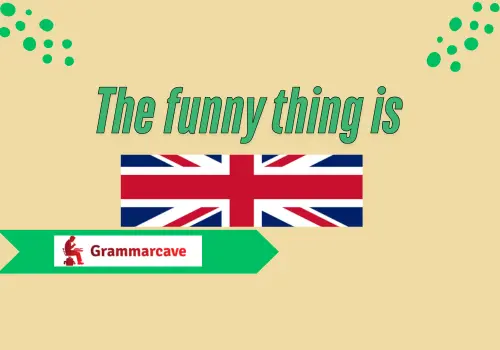
Meaning: Bring some irony, humor, or coincidence
Definition: Introduces a lighthearted or unexpected observation
Explanation: Usually precedes something funny or surprising
Example: “Funny thing is – he turned out to be my neighbor.”
Best use: Humor, casual talks, writing hooks
Worst use: Solemn discussions
Tone: Light, humorous, ironic
96. Respectful aside
Meaning: A polite digression or clarification
Definition: An interjection mindful of the tone and the subject matter
Explanation: Used frequently whilst intervening without sidetracking the main topic
Example: “A respectful aside – Thank you for staying late yesterday.”
Best use: Professional discussions, commendation
Worst use: Gritty Criticism or Sarcastic Tone
Tone: Polite, warm, formal
97. No offense, but…
Meaning: Acknowledges a statement that could be taken offensively.
Definition: A term to cushion or soften a critical comment.
Explanation: Usually followed by supposedly disagreement or critique.
Example: “No offense, but that logo feels really outdated.”
Best use: For honest feedback and informal honesty in general.
Worst use: Professional meetings can still hurt the feelings of someone.
Tone: Defensive, informal, and somewhat risky.
98. May I say
Meaning: An opinion is stated politely.
Definition: A lead-in used respectfully to an observation or thought.
Explanation: It is a comment of a more polite and gracious nature.
Example: “May I just say that your presentation was excellent?”
Best use: Public events and polite conversations.
Worst use: Candid critiques or casual joking.
Tone: Of gratitude and respect, formal.
99. Sorry to shift gears
Meaning: Marks a topic change.
Definition: A polite term to switch subjects.
Explanation: Shows awareness that it might feel somewhat abrupt.
Example: “Sorry to shift gears, but have we confirmed Friday’s booking?”
Best use: Useful in meetings and such.
Worst use: If the email is about a single topic.
Tone: Thoughtful, smooth, semiofficial.
100. I hesitate to say this, but…
Meaning: The introduction to a delicate or uncertain point.
Definition: A phrase that indicates caution in making sensitive statements.
Explanation: Generally softens criticism or unwanted comments.
Example: “I hesitate to say it, but I think the campaign went astray.”
Best use: Personal feedback, critique, serious discussion.
Worst use: Lighthearted or two-penny conversation.
Tone: Cautious, serious, sincere.
FAQ’s
1. What does by the way in English mean?
It’s a phrase used to gently introduce a side note or switch the subject.
2. Is it formal or informal incidentally?
By the way, it is usually informal but can be employed in semiformal contexts.
3. Some professional substitutes for by the way are?
Good words include “incidentally,” “as a side remark,” or “additionally”.
4. Am I permitted to employ by the way in emails?
Yes, but it works best in casual or friendly emails rather than in formal business writing.
5. Why ought I employ alternatives?
Various expressions fit different tones and clarify communications.
Conclusion
Though it is a basic colloquial expression, its influence on interaction is very significant. It gives our speech a casualness and flow, whether used to introduce a side note, smooth transitions, or discreetly change topics. Knowing its tone and options enables you to adapt your communications for casual meetings as well as professional interactions. Therefore, keep in mind—phrases like “by the way” are little tools with great conversational value—the next time you get the inclination to pivot or add context.


